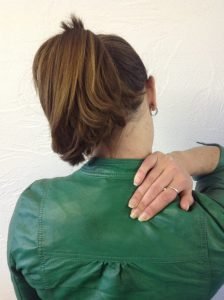Neck Pain & Chiropractic

Neck pain (or cervicalgia) is the second most common problem seen by chiropractors after low back pain.
Up to two-thirds of the population will have neck pain at some point in their lives.
Today’s modern living often entails hours of poor posture resulting from driving, working with computers and at desks, and repetitious habits which can play havoc with our necks.
It is therefore of no surprise that millions of people around the world experience neck pain and related arm pain at some stage in their lives and therefore seek chiropractic care.
Neck pain, although felt in the neck can be caused by numerous other spinal problems and may give rise to a variety of other systems in the arms, head, jaw and chest.
What structures make up the neck?
Your neck is a complex interlocking structure consisting of bones, joints, nerves, muscles, tendons and ligaments.
Seven bones called vertebrae make up the cervical spine. The neck’s main job is to hold up the weight of your head which, at around 5 kilograms is a heavy structure.
The top three joints in the neck allow for most movement of the neck and head. The lower joints in the neck and those of the upper back create a supportive structure for the head to sit on.
Each vertebra is connected to the next by facet joints, and between the vertebrae are inter-vertebral discs — rubbery cushions made mostly of cartilage that act as shock-absorbers.
A forward curve or lordosis is normal in the neck, this allows for shock absorption. Ligaments and muscles allow the spine to have both movement and stability.
What is Neck Pain?
Neck pain can vary from minor discomfort to severe burning pain. Neck problems can be caused by injury and poor postures.
The most common causes that chiropractors identify and treat are soft tissue abnormalities from injury or prolonged wear and tear.
When neck pain is caused by muscle spasm or strain, you may have aches and stiffness that spread to the upper arm and forearm.
Shooting pain that spreads down the arm into the hand and fingers can be a symptom of a pinched nerve or nerve entrapment in the neck.
When a nerve is ‘pinched’ in the neck, numbness, weakness and possibly pain of the hands or arms may occur.
Types of Neck Pain
Acute neck pain: A sudden and strong pain neck
Chronic neck pain: Pain lasted from more than three months.
Causes of Neck Pain
The causes that can trigger neck pain:
- ongoing poor posture
- muscle spasm and tightness
- trauma or injury including whiplash
- diseases such as arthritis or degeneration of the discs
Symptoms of Neck Pain
Symptoms of neck pain and the sensations you feel can help your doctor to diagnose the cause. Here are some symptoms.
Muscle spasm
A spasm is a sudden, powerful, involuntary contraction of muscles. The muscles feel painful, stiff and knotted. If you have neck muscle spasms, you may not be able to move your neck — its sometimes called an acute torticollis or a crick in the neck.
Muscle ache
The neck muscles are sore and may have hard knots (trigger points) that are tender to touch. Pain is often felt up the middle of the back of the neck, or it may ache on one side only.
Stiffness
The neck muscles are tight and if you spend too long in one position they feel even tighter. Neck stiffness can make it difficult or painful to move your neck.
Nerve pain
Pain from the neck can radiate down the arms, and sometimes, the legs. You may feel a sensation of pins and needles or tingling in your arms, which can be accompanied by numbness, burning or weakness. This pain is typically worse at night.
Headaches
Headaches are common in conjunction with neck problems. They are usually a dull aching type of headache, rather than sharp pain. While the headaches are often felt at the back of the head, the pain may also radiate to the sides, and even the front of the head.
Reduced Range of Motion
If you can’t turn your head to the side to the same degree towards each shoulder, or you feel limited in how far forward you can lower your head to your chest, or how far you can tilt your head back, you may have reduced range of motion. Your chiropractor will be able to test this.
What Does a Chiropractor do for Neck Pain?
Before deciding which approach to try for your pain, the chiropractor will do a thorough examination to diagnose the specific cause of your neck pain.
Your chiropractor will determine any areas of restricted movement and will look at how you walk as well as your overall posture and spinal alignment.
Doing these things can help your chiropractor understand your body mechanics.
In addition to the physical exam, you’ll also go through your past medical history with the chiropractor, and he or she may order or review existing results from an x-ray, CT or MRI to help diagnose the exact cause of your neck pain.
All these steps in the diagnostic process will give your chiropractor more information about your neck pain, which will help your chiropractor create a treatment plan customized for you.
